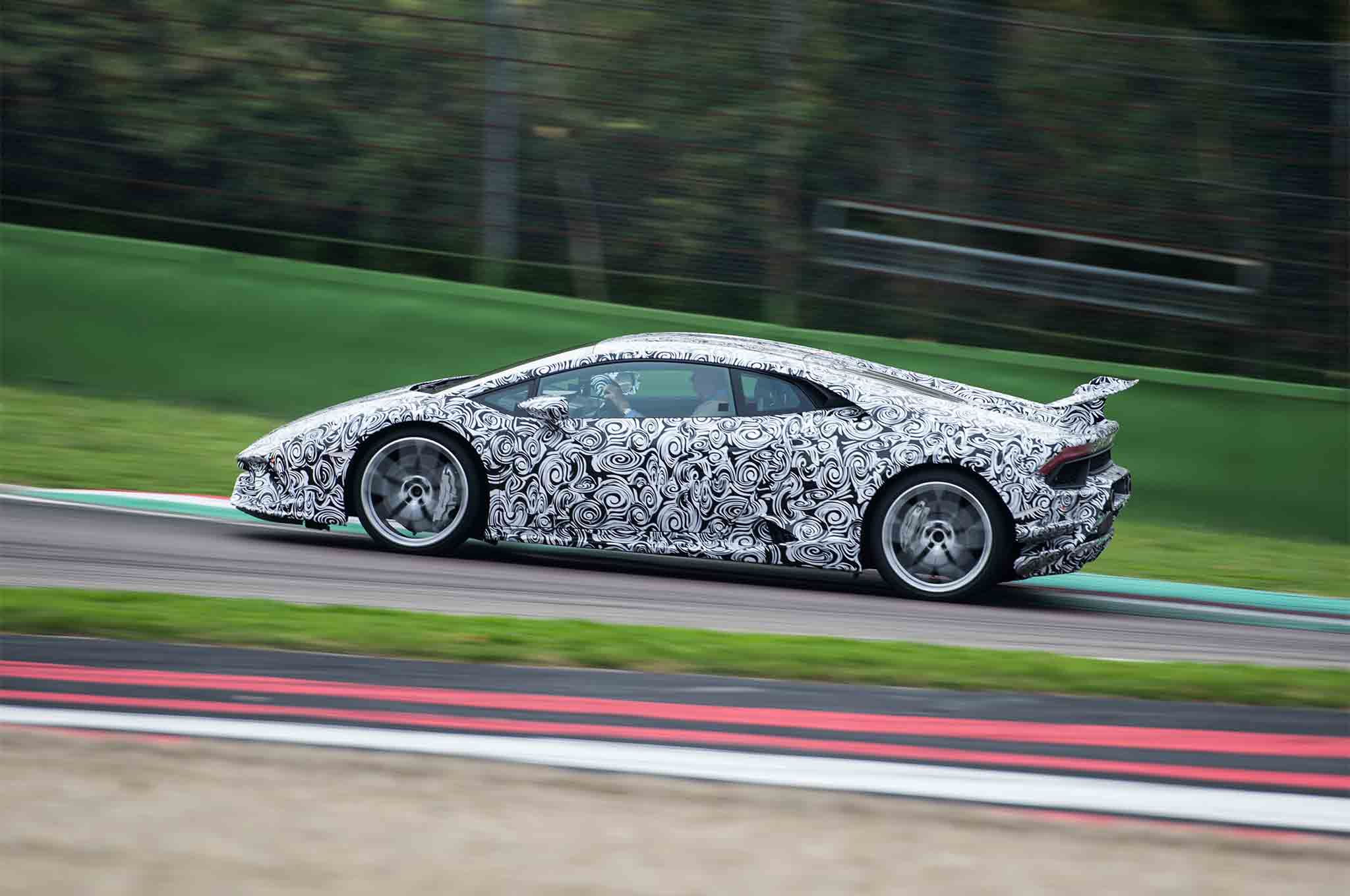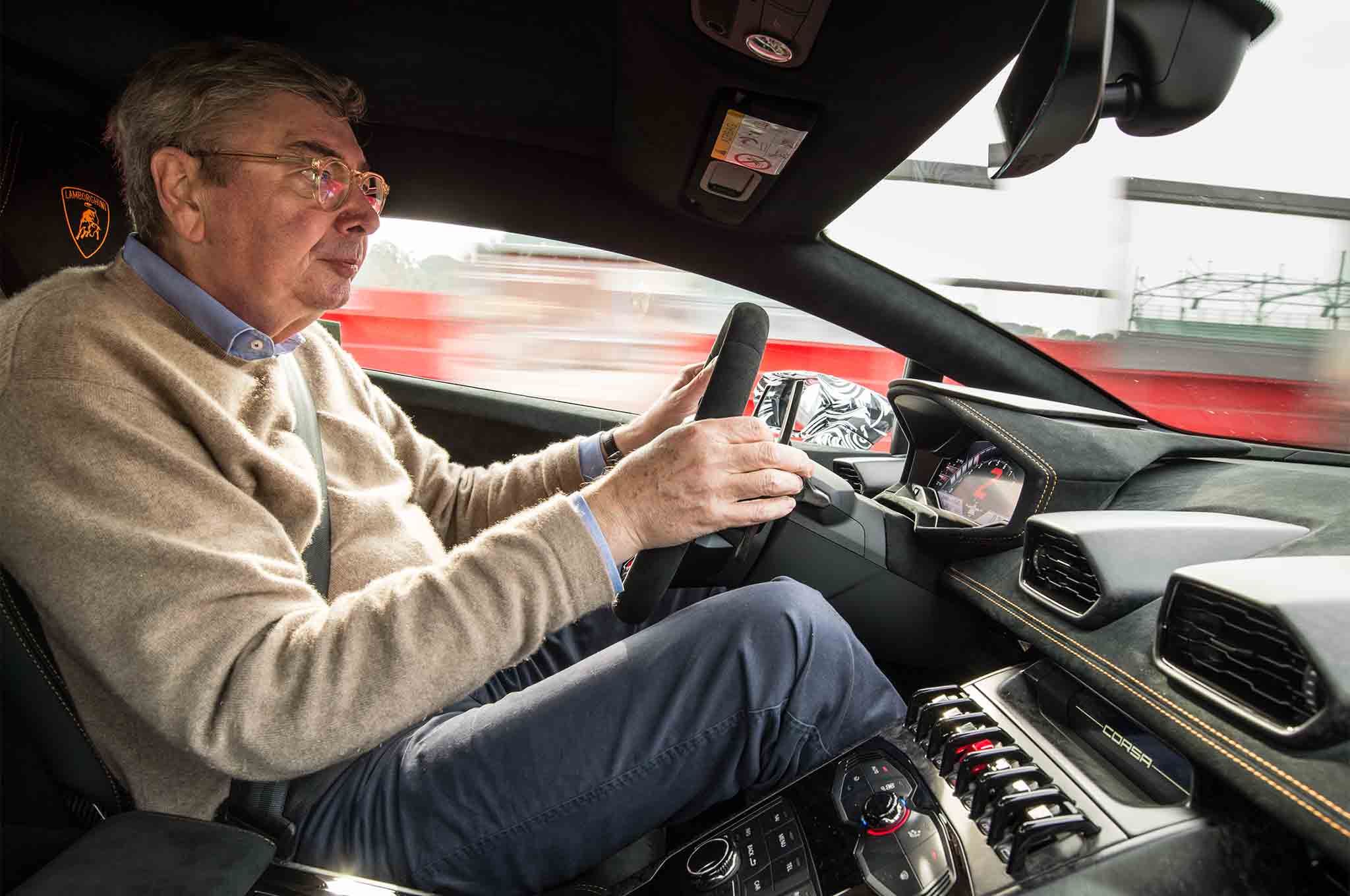Prototype Drive: Lamborghini Huracán Performante

In the Slipstream of Perfection: Latest Huracán variant is a Supertrofeo for the road
By: Georg Kacher January 16, 2017
IMOLA, Italy — It’s 8 a.m. on a chilly December morning, and although the Imola F1 circuit in northern Italy should already be in hibernation, the place is bustling with activity.
Our host for today’s event is Maurizio Reggiani, Lamborghini’s charismatic R&D chief. Reggiani is an utterly charming and knowledgeable top manager whose main mission in life is to reinvent Lamborghini.
“This is a very special brand that builds very special cars,” Reggiani says. “But in today’s economic climate, we must fight for our goals every step of the way.”
Although Huracán and Aventador are doing well in the marketplace, money is tight in the small Italo-German enclave north of Bologna. Before Reggiani and his team get the nod to introduce an all-new design or an additional product, they must first milk the existing range by launching at least two highly profitable special-edition models per year throughout the life cycle.
Kicking off 2017 is the Huracán Performante, which officially bows in March at the 2017 Geneva auto show. This time, the Performante label stands for much more than fancy wheels, loud stripes, and 15 or 20 extra horsepower.

“The new Performante is, in essence, a Super Trofeo for the road,” states senior vehicle development manager Dennis Schmitz. “What makes all the difference is the patented ALA concept, short for Active Lamborghini Aerodynamics. It transforms the car by enhancing cornering grip, handling prowess and high-speed stability. Driving is believing. This really is a Performante worthy of its badge.”
We don’t get a full look at the Huracán Performante prototype’s sheetmetal, which is wrapped in swirly black-on-white camouflage. A close look reveals a redesigned nose cone, revised air intakes, and an imposing rear wing sitting on two wide mounts. Is this really all it takes to create what is being heralded as a dynamic miracle?
“There is more to this system than meets the eye,” promises chief aerodynamicist Antonio Torluccio, “like precise torque vectoring by air-flow management.” Seems we are on to something interesting here.
Imola is a fantastic track. With the possible exception of the chicane, there isn’t a single second-gear corner. Instead, the mind is boggled by plenty of high-speed stuff. It’s a mix of third, fourth, and fifth gear, then up to sixth toward the end of the start-finish straight.
The Performante effect is immediate. Not because of the 10 percent power boost and the extra 54 lb-ft of torque. It’s the transformed road-holding that makes you shake the head in disbelief, again and again.
In a way, hard cornering in the Performante feels like slalom skiing. You are constantly in the flow, shifting weight from one side to the other, fighting and eventually conquering g-force with downforce. While the benefit is totally symmetrical under hard braking, aero vectoring automatically shifts the load to the inner rear wheel when cornering at the limit of adhesion. The system not only generates a precious extra 0.2 to 0.4 g within fractions of a second, it also suppresses understeer by permitting smaller steering angles.
While the fast-acting single electric motor quashes axle lift by closing the front flaps, the rear wing is a much more complex assembly. The hollow wing profile consists of two separate chambers and a pair of narrow, full-width underside slots. The air flow is masterminded (and split, more often than not) by two independent aero shutters attached to the base of the two hollow stanchions supported by the main spoiler. Progressively picking up speed, air enters the wing and is compressed before exiting through one or both concealed slot diffusers, thereby creating substantial downforce.
During our first pit stop, a brief discussion ensues about the appropriate ESP setting.
“Sport is dedicated to make the car feel a little loose and tail-happy,” explains Lorenzo Rinaldi, who is in charge of vehicle dynamics. “For the fastest lap times, however, you’re better off in Corsa. It is more focused and sharper overall. Alternatively, you can of course switch off stability control altogether.”
In Sport, both air flaps open to boost downforce in the critical 45 to 112 mph bracket. Beyond 193 mph, the rear flap opens for maximum drag reduction.

In Strada, they both open at 45 mph. Above 193 mph, the front air flow control blades close to reduce lift. Only in Corsa is there a constant front-to-rear and left-to-right interplay to optimize the cornering performance. The aerodynamic balance is, in essence, determined by lateral and longitudinal acceleration.
Other contributing factors to the Huracán Performante’s abilities include an 88-pound weight reduction, bespoke Pirelli P Zero Corsa tires, more aggressively calibrated AWD and ESP systems, a free-breathing exhaust with high-mounted tailpipes, a faster shifting seven-speed dual-clutch transmission, and notably stiffer suspension mounts.
But perhaps the most significant dynamic alteration is the reprogrammed steering. The effort is now slightly higher in Strada, the ratio quickens in Sport, and there is no longer any variation at all in Corsa — exactly the way Porsche does it.
The Performante sounds rawer and meaner than the average Huracán, and its turbo-free long-stroke V-10 pushes some 650 horsepower (final figures won’t be available before March). It draws an even prouder torque curve. According to gossip, the power boost will help the car shave roughly three-tenths off the base Huracán’s 0-60 mph acceleration time. Top speed may not matter much anymore these days, but at a rumored 210 mph, this bull would eclipse the R8 V10 plus, which helps when it’s bragging time down at the club.
Its surround sound intake system, derived from the Super Trofeo race car, clears its throat at 3,000 rpm before raucously and rapidly reeling in the 8,500-rpm redline. Backpressure is an alien term to the lightweight exhaust and completing the package is a transmission that hammers its seven gears like a violent electro-mechanical robot.

Its substantially stiffer chassis is a tangible asset when fighting the paling red, white, and green curbs. But despite this sadomasochistic calibration, the ride quality on public roads barely suffers, claims project leader Antonio Grandi. “Especially in Strada, springs and dampers are sufficiently pliable. Maximum downforce does, of course, have an effect on the compliance.”
The Huracán Performante is amazingly stable under hard braking, controls its body movements with the composed virtuosity of a Yoga guru, and sticks to the line like a fast-moving magnetic field guided by an invisible induction loop. Confidence at the limit can easily be stretched from an unperturbed 10 tenths to an only slightly more frivolous 11. What lies beyond would require a stab at the ESP button, a move that calls for a better and more courageous driver.
But the itch to take a little more risk for a potentially bigger reward gains the upper hand. We carry fractionally more speed into the next corners to test the buffer zone between physical and aerodynamic grip. Brake half a foot and then a full foot deeper into bends to sample the demarcation area between turn-in and understeer. Stay in third gear through the chicane with three wheels momentarily on the ground to find out whether the fast-acting torque split and the flippant ESP calibration will straddle the line between drama and disaster.
Despite being a pain to get into and an embarrassment to get out of, in the end what happens between these two procedures is dazzling, physical, and addictive. And while the Performante may not beat the Ferrari 488 and McLaren 570S in the nominal horsepower, torque, and miles-per-hour sweepstakes, it is bound to keep in close touch with its rivals in real life thanks to the game-changing adaptive aerodynamics. Avete lavorato stupendamente, ragazzi!
http://www.automobilemag.com/news/lamborghini-huracan-performante-prototype-drive/



